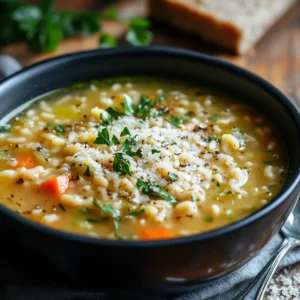Introduction to Pastina Soup Recipe
When it comes to comfort food, nothing beats the simplicity and warmth of a pastina soup recipe. This Italian classic, made with tiny pasta shapes and a flavorful broth, is perfect for chilly days, quick dinners, or soothing a sore throat. Loved by both kids and adults, pastina soup combines nourishment with nostalgic charm.
In this guide, we’ll dive deep into everything you need to know to make the perfect pastina soup recipe, from its ingredients to variations and expert tips.
Ingredients Overview
Essential Ingredients for Pastina Soup
- Pastina Pasta – The star of the dish, available in tiny shapes like stars, orzo, or acini di pepe.
- Broth – Chicken, vegetable, or beef broth serves as the flavorful base.
- Butter or Olive Oil – Adds a rich, comforting touch.
- Cheese – Parmesan or Pecorino Romano enhances the flavor.
- Seasonings – Salt, pepper, and herbs like parsley or thyme.
Ingredient Variations
- For Vegans: Replace chicken broth with vegetable stock and skip the cheese.
- For a Richer Flavor: Use homemade broth or bone broth.
- For Gluten-Free Options: Substitute pastina with gluten-free pasta alternatives.
Substitutes for Hard-to-Find Ingredients
- Use couscous or quinoa if pastina is unavailable.
- Nutritional yeast can replace cheese in vegan versions.
Nutritional Benefits of Pastina Soup
Pastina soup is not only delicious but also offers several nutritional benefits. It’s a meal that can easily fit into a balanced diet. Let’s break it down:
1. Rich in Carbohydrates for Energy
First and foremost, the pastina pasta provides a good source of carbohydrates, which are essential for energy. Whether you’re serving it to kids after school or enjoying it yourself after a long day, this dish delivers a comforting energy boost.
2. Packed with Protein
If you use chicken or beef broth, the soup becomes a source of high-quality protein. Protein is vital for muscle repair and growth, making this dish both comforting and nourishing.
3. Full of Vitamins and Minerals
Next, adding vegetables like carrots, celery, or spinach enhances the soup’s nutritional profile. These ingredients provide vitamins like A and C, along with essential minerals like potassium and magnesium.
4. A Hydrating Option
Additionally, the broth in pastina soup helps with hydration. This is especially beneficial during illness or on dry winter days when staying hydrated is crucial.
Step-by-Step Guide to Making Pastina Soup
Crafting the perfect pastina soup recipe is straightforward, but breaking it into manageable steps ensures you achieve the best results. Follow this guide for a foolproof process:
1. Gather Your Ingredients

Before you start cooking, ensure you have all the necessary ingredients ready. Measure the pastina (around ½ cup per serving), prepare your broth, and chop any vegetables or herbs you’d like to include. Proper preparation makes the cooking process smoother.
2. Heat the Broth
Begin by pouring the broth into a medium-sized pot. Heat it over medium heat until it’s warm but not boiling. While this step may seem simple, ensuring the broth is evenly heated sets the foundation for the soup’s flavor.
3. Cook the Pastina
Once the broth is ready, add the pastina gradually, stirring occasionally to prevent clumping. Let it simmer for 5–7 minutes, or until the pasta is tender. Be careful not to overcook the pastina, as it can turn mushy.
4. Add Final Touches
After the pastina is cooked, enhance the soup’s flavor by stirring in a pat of butter or a drizzle of olive oil. Sprinkle grated Parmesan or Pecorino Romano cheese for a creamy, savory finish. Adjust the seasoning with salt and pepper as needed.
5. Serve and Enjoy
Finally, ladle the soup into bowls and garnish with chopped parsley or a drizzle of olive oil for added flavor and presentation. Serve immediately while it’s warm for the best taste and texture.
Variations of Pastina Soup Recipes
Classic Italian Style
Stick to the basics with pastina, chicken broth, butter, and Parmesan cheese for a simple yet comforting bowl of soup. These few ingredients come together to create a deliciously warm and flavorful dish. The pastina absorbs the rich chicken broth, while the butter adds a silky texture. A generous sprinkle of Parmesan cheese enhances the soup with a savory, umami kick, making it the perfect balance of flavors. This minimalist approach allows each ingredient to shine, creating a heartwarming meal that’s easy to prepare and enjoy.
Creamy Pastina Soup
Incorporate a splash of heavy cream into your pastina soup for a rich, velvety texture. The cream adds a luxurious smoothness that enhances the soup’s flavor, making it even more comforting and indulgent. With just a small amount, the heavy cream creates a creamy consistency without overpowering the other ingredients. This simple addition transforms your basic pastina soup into a decadent dish that’s both satisfying and delicious.
Vegetarian and Vegan Options
Swap out the chicken broth for vegetable stock to create a lighter, vegetarian-friendly version of pastina soup. Vegetable stock provides a rich, savory base that complements the pasta without the need for animal products. For an added depth of flavor, sauté some mushrooms and stir them into the soup. The mushrooms will bring an earthy, umami kick that enhances the overall taste, giving the soup a more robust and satisfying flavor profile. This simple variation makes the soup both hearty and flavorful, perfect for those looking for a plant-based option.
Chicken Pastina Soup
Add shredded chicken to your pastina soup for a protein-packed meal that’s both hearty and nutritious. The tender chicken not only boosts the protein content but also adds a savory depth to the soup, making it more filling and satisfying. Whether you’re using leftover chicken or cooking it fresh, the addition of shredded chicken turns your simple pastina soup into a well-rounded dish that can easily serve as a main course for lunch or dinner. This easy addition makes the soup even more comforting and nourishing, perfect for a balanced meal.
Tips for Enhancing Flavor
-
- Best Herbs: Fresh herbs like parsley, basil, or thyme can truly enhance the taste of your soup. Parsley adds a refreshing, slightly peppery note, while basil introduces a fragrant, slightly sweet flavor. Thyme offers a savory depth that complements the other ingredients, making the soup more aromatic and flavorful.
- Secret Ingredients: For an unexpected burst of flavor, try adding a dash of nutmeg or a squeeze of lemon juice. Nutmeg adds a warm, subtle spice that deepens the overall taste of the soup, while lemon juice brings a bright, zesty contrast that can balance the richness of the broth.
- Broth Pairing: The quality of your broth is essential to the success of your pastina soup. For the best results, use a rich, homemade broth. Whether you choose chicken, vegetable, or another type of broth, a homemade version adds a depth of flavor and richness that store-bought varieties often lack, making your soup truly exceptional.
These simple additions and techniques can take your pastina soup from ordinary to extraordinary, enhancing both its taste and aroma.
Serving Suggestions
- Pastina soup is a versatile dish that can be paired with a variety of sides to enhance its flavor and make it a well-rounded meal. Here are some great pairing ideas:
- Pair with Crusty Bread or a Fresh Green Salad: Serve your pastina soup with a slice of crusty bread for dipping or alongside a refreshing green salad. The bread adds a satisfying crunch, while the salad offers a light, crisp contrast to the warmth and comfort of the soup.
- Serve in Smaller Portions as an Appetizer or Larger Bowls as a Main Course: Depending on the occasion, pastina soup can be served in smaller portions as a flavorful appetizer or in larger bowls for a hearty main course. Its versatility makes it perfect for any meal, whether you’re starting with a light bite or enjoying a filling dish.
- Add Colorful Garnishes like Chopped Parsley or a Drizzle of Olive Oil: To add a pop of color and extra flavor, garnish your pastina soup with fresh chopped parsley or a drizzle of high-quality olive oil. These simple touches not only enhance the presentation but also contribute to the overall taste and aroma of the soup.
With these pairing tips, pastina soup becomes a delightful and customizable dish that can be enjoyed in many different ways, making it perfect for any occasion.
Common Mistakes to Avoid
- When making pastina soup, there are a few common mistakes to avoid to ensure the best flavor and texture:
- Overcooking the Pasta: Always cook the pastina until it’s just tender. Overcooking the pasta can cause it to become mushy and lose its perfect texture. Keep an eye on the cooking time and test the pasta to ensure it’s cooked to your liking.
- Too Much Salt: Be mindful of the amount of salt you add. Both the broth and cheese used in the soup already contribute a significant amount of saltiness, so it’s important to season carefully. Taste the soup before adding any extra salt to avoid over-seasoning.
- Skipping Sautéing: If you’re using vegetables in your pastina soup, don’t skip the step of sautéing them first. Sautéing helps to enhance their natural flavors and creates a richer, more flavorful base for your soup.
By avoiding these common mistakes, you’ll create a delicious, well-balanced pastina soup that’s sure to please everyone.
Cultural Significance of Pastina Soup
Pastina soup holds a special place in Italian culture, symbolizing comfort and tradition. Its simplicity has allowed it to remain a beloved dish for generations. Let’s explore its cultural importance:
1. Traditional Role in Italian Cuisine
First and foremost, pastina soup is deeply rooted in Italian culinary traditions. It is often the first solid food introduced to babies, given its easy-to-digest texture and nourishing qualities. Moreover, it is a staple in family meals, especially during colder months or when someone feels unwell.
2. Use in Celebrations and Holidays
Beyond everyday meals, pastina soup is also served during festive occasions. For example, some families include it as a light starter during Christmas dinners or other holiday gatherings. Its comforting nature makes it a welcome addition to celebratory feasts.
3. Symbolism as Comfort Food
Additionally, pastina soup is more than just a dish—it’s a symbol of care and love. Parents prepare it for children, and it’s often made for loved ones recovering from illness. This dish transcends its ingredients, representing a heartfelt gesture of comfort and nurturing.
Storage and Leftovers
- Proper storage and handling of pastina soup ensure you can enjoy it even after the first serving. Let’s explore the key steps:
1. How to Store Pastina Soup
If you have leftover pastina soup, transfer it to an airtight container to keep it fresh. Store it in the refrigerator, where it will remain good for up to 3 days. However, remember that the pasta may continue to absorb the broth, so you might need to add more liquid when reheating.
2. Reheating Tips
When you’re ready to enjoy the soup again, gently reheat it on the stove over low to medium heat. While heating, stir occasionally to prevent sticking and ensure even warming. If the soup has thickened too much, add a splash of broth or water to restore its consistency.
3. Creative Ways to Use Leftovers
Instead of simply reheating, you can transform leftover pastina soup into something new. For instance:
- Bake it with extra cheese for a creamy casserole.
- Use it as a base for another soup by adding fresh vegetables or beans.
- Turn it into a hearty stew by mixing in shredded chicken or lentils.
Pastina Soup for Dietary Needs
- When preparing a healthier version of your favorite soup, there are simple swaps you can make to accommodate different dietary needs:
- Gluten-Free: To make your soup gluten-free, use rice-based or gluten-free pasta. These options provide the same comforting texture as regular pasta, without the gluten, making it suitable for those with gluten sensitivities or celiac disease.
- Low-Sodium: To reduce the sodium content, opt for low-sodium broth and cheese. Many store-bought broths contain high levels of sodium, but choosing a low-sodium version helps to keep the dish healthier while still maintaining rich flavor. Likewise, using a reduced-sodium cheese can prevent the dish from becoming too salty.
- Low-Calorie: For a lighter version of your soup, skip the butter and use whole-grain pastina instead. Whole-grain pastina provides a healthy dose of fiber, making the soup more filling without adding excess calories. This swap allows you to enjoy a lighter meal without compromising on taste.
By making these simple adjustments, you can create a soup that meets various dietary preferences while still being delicious and satisfying.

FAQs
Why is Pastina Considered a Comfort Food?
Its simple ingredients and warm, soothing nature make it a go-to for all ages.
How Long Does It Take to Cook?
Typically, 5–7 minutes for the pasta, with an additional few minutes for prep.
What Is the Best Type of Broth to Use?
Homemade chicken or vegetable broth is ideal for flavor.
Can I Make It in Advance?
Yes, but cook the pasta separately to avoid it soaking up too much liquid.
What Vegetables Can I Add?
Carrots, celery, spinach, or peas are excellent additions.
Is Pastina Soup Suitable for Toddlers?
Absolutely! It’s soft, easy to digest, and nutritious.
Popular Myths About Pastina Soup
Soup is a comforting, versatile dish loved worldwide, yet several misconceptions can prevent people from fully appreciating its charm. Let’s dispel these myths and uncover the truth.
“Only for Children”: Soup is for Everyone!
Although often associated with childhood meals, soup is a universal favorite enjoyed by people of all ages. Its versatility makes it appealing to adults, offering everything from creamy tomato bisques to hearty chicken noodle or vegetable-packed broths. Soup’s soothing warmth and endless customization options make it a top choice for anyone seeking a satisfying and nutritious meal, regardless of age.
“It Cures Colds”: Not a Cure, But a Comfort.
Soup is commonly believed to cure colds, but while it isn’t medicinal, it does provide soothing relief. The warmth of the broth hydrates and eases sore throats, while the nutrients from vegetables, grains, and proteins support the immune system. Chicken soup, for example, has been cherished for generations, offering comfort and nourishment when you’re under the weather. Though it doesn’t cure illness, its benefits to well-being are undeniable.
“Hard to Make”: Soup is Incredibly Easy!
Many shy away from making soup, assuming it’s too complex, but nothing could be further from the truth. Soup is one of the simplest dishes to prepare, requiring only a few basic ingredients and minimal effort. Whether you’re simmering a slow-cooked stew or whipping up a quick broth-based soup, recipes are highly adaptable to what you have on hand. It’s perfect for beginner cooks and a great way to use leftover ingredients.
By debunking these myths, we see soup for what it truly is: a nourishing, easy-to-make meal that brings comfort and joy. Suitable for everyone and endlessly adaptable, soup is a timeless dish worth embracing in kitchens everywhere.
Conclusion
Crafting a delicious pastina soup recipe is an art of simplicity and love. With endless variations and the ability to cater to various dietary needs, this dish is a timeless favorite. Experiment with ingredients, serve with joy, and create lasting memories around the table.
Explore more comforting, flavorful dishes to try today!


